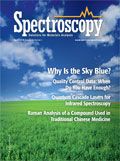Market Profile: Portable Molecular Spectroscopy in Biopharma
Portable molecular spectroscopy techniques used in the pharmaceutical and biopharmaceutical industries consist of Raman, infrared (IR), and near-infrared (NIR) spectroscopy.
Portable molecular spectroscopy techniques used in the pharmaceutical and biopharmaceutical industries consist of Raman, infrared (IR), and near-infrared (NIR) spectroscopy. By far the most common application for their use is for inspection and verification of incoming and sometimes outgoing products, including excipients, active pharmaceutical ingredients (APIs), intermediates, and finished products, usually on the shipping dock or in the warehouse. The use of such instrumentation can quickly and accurately verify the correct labeling of such products, adding a layer of security against costly and potentially harmful errors. In addition, such analytical techniques can also detect significant problems in product formulations that could be the result of processing errors or adulteration.
Raman spectroscopy, which accounts for the majority of the more than $30 million pharmaceutical and biopharmaceutical portable molecular spectroscopy market, provides very specific chemometric information and is not interfered with by moisture, although it is somewhat more expensive. Portable NIR instruments are significantly less expensive, but are less specific and generally require modeling of the samples to be analyzed. In addition, moisture interferes in NIR analysis, which limits its use to inspection of dry products. Mid-IR spectroscopy can also be interfered with by moisture, but tends to be better for chemical analysis, including gas detection. As a result, mid-IR spectroscopy is used more often for security and safety applications than in the pharmaceutical and biopharmaceutical industry. Overall growth for portable molecular spectroscopy in the pharmaceutical and biopharmaceutical market will likely be in the single digits in 2013 before returning to a double-digit pace.

Portable molecular spectroscopy - pharmaceutical and biopharmaceutical demand, 2012.
The foregoing data were extracted from SDi's market analysis and perspectives report titled Advanced Portable & Handheld Analytical Instruments: Moving Modern Analyses Beyond the Laboratory, July 2012. For more information, contact Stuart Press, Vice President, Strategic Directions International, Inc., 6242 Westchester Parkway, Suite 100, Los Angeles, CA 90045, (310) 641-4982, fax: (310) 641-8851, www.strategic-directions.com.

Portable and Wearable Spectrometers in Our Future
December 3rd 2024The following is a summary of selected articles published recently in Spectroscopy on the subject of handheld, portable, and wearable spectrometers representing a variety of analytical techniques and applications. Here we take a closer look at the ever shrinking world of spectroscopy devices and how they are used. As spectrometers progress from bulky lab instruments to compact, portable, and even wearable devices, the future of spectroscopy is transforming dramatically. These advancements enable real-time, on-site analysis across diverse industries, from healthcare to environmental monitoring. This summary article explores cutting-edge developments in miniaturized spectrometers and their expanding range of practical applications.
Q&A: Portable FT-IR Empowers On-Site Food Quality Assurance
February 1st 2024Exploring the transformative capabilities of handheld Fourier transform infrared (FT-IR) spectrometers, Luis Rodriguez-Saona of The Ohio State University emphasizes their pivotal role in ensuring food integrity and safety across the entire supply chain.
Portable Raman Spectrometers: How Small Can They Get?
June 1st 2023There is a growing desire among spectroscopists for having instruments small enough to be taken to the sample, as opposed to bringing the sample to the instrument. The result is that Raman spectrometers are becoming more miniaturized. Because these instruments come at a lower cost and offer distinct advantages over traditional spectrometers, the expectation is that a rapid expansion of when these instruments are applied will come forthwith. We offer a preview of how future miniaturized Raman spectrometers might look.